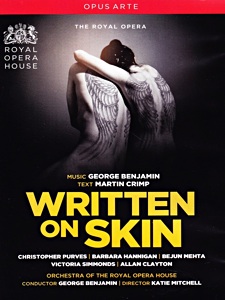
George Benjamin’s 2012 opera Written on Skin received great acclaim at its opening at the Festival d’Aix-en-Provence, and the Royal Opera quickly mounted it in March 2013. Seen in this DVD from Opus Arte
, the work has a great deal going for it: an impeccable cast of committed singing actors, Benjamin himself as conductor, a libretto (here called “text”) by the modernist British playwright Martin Crimp, and the excellent forces of the Orchestra of the Royal Opera House.
Based on a 13th century Provençal tale, the story is bleak and grim in the extreme. The Protector (a powerful land baron) commissions a young artist (The Boy) to make an illustrated book about his life and work. The Protector’s wife, Agnes (The Woman), frustrated at her lot in life (The Protector calls her body “his property”) and her lack of passion for her husband, soon enters into a frenzied sexual affair with The Boy. The Protector, seemingly ambivalent about his own feelings for The Boy, soon learns of the affair, murders The Boy, and, shades of Titus Andronicus, feeds his heart to Agnes. Agnes tells her husband that “nothing will ever take the sweet/salty taste of The Boy’s heart from her mouth”, then leaps to her death from the top of the castle.
The opera features a cast including The Protector, Agnes, and seven “angels,” one of whom plays The Boy, another Agnes’ sister Marie, another her husband John. The Angels do all the scene changes, prepare the props and costume changes, even move the principal characters into their proper positions. Stage director Katie Mitchell and designer Vicki Mortimer set the opera in a two-level, four-room stage.
The rooms stage left are the “medieval rooms” where the story takes place; the rooms stage right are the “modern rooms” where The Angels do their work. In Crimp’s text, modern references to such things as the “Saturday car park” fold seamlessly into the medieval story. While these modern/medieval references sometimes seem clumsy devices, they do provide an essential through-line to the theme of the opera: the human condition and human cruelty and obsession are timeless.
The performances are all splendid, both vocally and dramatically. Soprano Barbara Hannigan completely embodies the frustrated Agnes in a risky, gutsy performance that vividly illuminates every nuance of this complex, tortured character. The vocal gymnastics of the role are handled with ease and beauty. Ditto Bejun Mehta as the Boy, his voluptuous countertenor sounding clear and clean and hauntingly beautiful. Christopher Purves as The Protector brings a great sense of dangerous fury to the role while also conveying the terror of a man being questioned about his manhood for the very first time. Victoria Simmonds and Allan Clayton make the small roles of Marie and John sizzle with energy.
I found Crimp’s text frequently marvelous but also perplexing. There is something off-putting about the characters’ use of both first and third person throughout—“You’re in my light, says The Boy”, “And by day, says The Protector, fruit trees… turn towards the sun.” In Christopher Wintle’s essay that accompanies the disc, he refers to this as Brechtian—“continually distancing the audience in order to engage it more intensely.” While one does get used to this conceit as the opera progresses, I found in far more distancing than engaging. I was able to admire the structure of the story and the psychological agonies of the characters, but only in an objective way. It was often like peeking through a window at the action rather than empathizing with the situation.
My response to Benjamin’s score was also mixed. At first hearing, I found it noisy and rather generically “mysterious.” I also kept thinking that it sounded a lot like the results of putting Wozzeck, Pelleas, Lulu, and maybe Peter Grimes in a blender, seasoned with a touch of Stravinsky and Strauss. But later hearings began to reveal sonorities that are particular to Benjamin, as well as unique use of environmental sounds including pebbles falling, sleigh and cow bells, and the sound of a computer typepad. The music is effectively reflective of the sensuality, violence, sexuality, and suppressed emotion in the story. It is nevertheless most effective in its quiet, almost breath-holding moments; the over-the-top use of cymbals and crashing percussion in the story’s violent moments are simply noisy and off-putting.
Written On Skin is an admirable musical exploration of the darkest sides of human nature. It has much to say about the nature and cause of naked cruelty, about the results of the repression of women, about the abuse of power and the lengths that men will go to preserve it. There is also a fascinating look at sexuality in all its expressions—the moment in Part Two when The Protector suddenly kisses The Boy and it turns into a moment of passion that is never repeated or spoken of—is a dramatic surprise that adds to the sense of danger and unpredictability in the work that keeps it vividly alive.
The scenes build toward the harrowing climax where Agnes is forced to eat the heart of The Boy—a scene so stunning that it’s barely watchable—and, afterwards, there is no alternative to the suicidal outcome. In these moments of horror, Crimp’s text and Benjamin’s music truly come together to make a powerful statement. And, throughout, the extraordinary depth of characterization and ravishing singing from Hannigan, Mehta, and Purves is thrilling to see and hear.


























Comments